
Chapter 25: Digestion and Human Nutrition
25.1 Digestive System
One of the basic characteristics of life is the ability to acquire nutrients for energy to conduct activities of living.
In animals, the digestive system consists of organs involved in four processes:
Ingesting food
Breaking down food into smaller molecules that can be transported
Absorbing nutrient molecules
Eliminating indigestible materials
The digestive system maintains homeostasis by providing the body's cells with the nutrients they need to continue functioning.
The digestive system interacts with other organ systems of the body to maintain homeostasis.
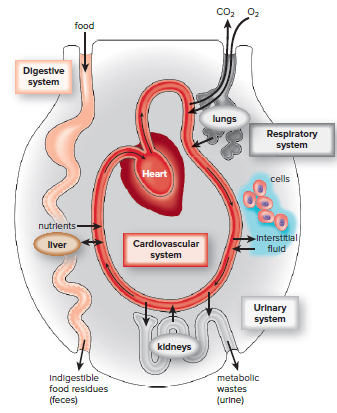
Complete and Incomplete Digestive Systems
Hydras and planarians have an incomplete digestive system with a single opening serving as both entrance and exit.
Most animals, like earthworms, have a complete digestive tract with a tube-within-a-tube configuration.
The inner tube, or the digestive tract, has both an entrance (the mouth) and an exit (the anus).
The inner tube is separated from the outer tube (the body wall) by the coelom.
Specialized organs that assist with digestion are located within the coelom.
Digestion of food is an extracellular process in all animals, including earthworms and humans.
Digestive enzymes are produced by glands in the wall of the digestive tract or by accessory glands that lie nearby and are released into the tract.
Food is never found within these accessory glands, only within the digestive tract itself.

The Digestive Tract
The digestive tract of humans, and most other vertebrates, consists of the mouth, esophagus, stomach, small intestine, and large intestine.
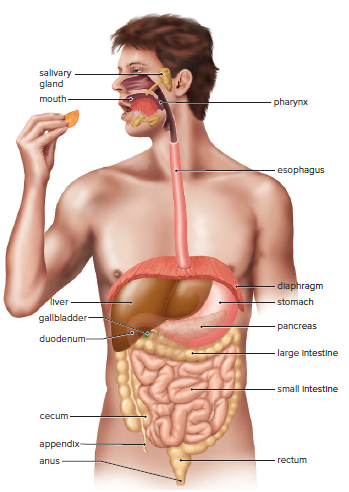
Mouth
The digestive system in humans begins with the mouth, where food is chewed into pieces, starting the process of mechanical digestion.
Many vertebrates have teeth, but birds lack teeth and use small pebbles in their gizzard to break up food.
Mammals' teeth reflect their diet, with carnivores having easily digestible meat and herbivores needing to break down cellulose walls in plant material.
Humans are omnivores with sharp incisors for biting, pointed canines for tearing, and premolars and molars for grinding and crushing food.
Digestive enzymes break down large molecules in food to smaller molecules.
Salivary glands in the mouth produce saliva, including salivary amylase which breaks down starch to maltose.
The tongue manipulates food and mixes it with saliva to form a bolus, which is then swallowed.
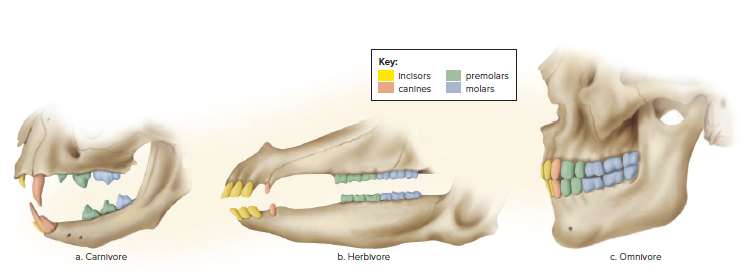
Swallowing
The human digestive and respiratory passages meet in the pharynx and then separate.
When food is swallowed, the soft palate moves up to close off the nasal cavities.
The epiglottis covers the glottis to prevent food from entering the larynx.
The bolus must move through the pharynx and into the esophagus because the air passages are blocked.
Food can sometimes go the wrong way, either into the nasal cavities or into the trachea.
The esophagus is a muscular tube that takes food to the stomach.
Peristalsis, a series of rhythmic contractions of smooth muscles, moves the contents along in tubular organs, including the esophagus.

Stomach
The human stomach:
Thick-walled, J-shaped organ on the left side of the abdominal cavity below the liver.
Continuous with the esophagus above and the duodenum of the small intestine below.
The cardiac sphincter separates the esophagus from the stomach.
About 25 cm (10 in.) long, regardless of the amount of food it holds.
The diameter varies depending on how full it is.
Receives food from the esophagus, stores food, starts the digestion of proteins, and moves food into the small intestine.
Wall has deep folds which disappear as the stomach fills to an approximate capacity of 1 liter.
Contains three muscle layers: longitudinal, circular, and obliquely arranged.
Mechanically digests food by contracting vigorously to mix it with digestive juices.
The epithelial lining of the stomach called a mucosa, has millions of gastric glands.
Gastric glands produce gastric juice containing hydrochloric acid and pepsin.
Strong acidity kills microbes and promotes the activity of pepsin.
Low pH sometimes causes heartburn or gastric reflux disease.
A thick layer of mucus protects the wall of the stomach from enzymatic action.
Ulcers are open sores in the wall caused by the gradual destruction of tissues.
Alcohol and other liquids are absorbed in the stomach, but other nutrients are not.
Peristalsis pushes food along in the stomach.
The pyloric sphincter is a narrow opening at the base of the stomach.
Chyme is a thick, soupy liquid that leaves the stomach and squirts through the pyloric sphincter into the small intestine.
Ruminants:
A type of mammal that includes cattle, sheep, goats, deer, and buffalo.
Named for a part of their stomach, the rumen.
Rumen contains symbiotic bacteria and protozoans that produce enzymes that can digest cellulose.
Herbivores feed on grass, which goes to the rumen and is broken down by the microbes, becoming small balls of cud.
Cud returns to the mouth, where the animal "chews the cud."
Cud may return to the rumen for a second go-round before passing through the other chambers of the stomach.
Rumen is an adaptation to a diet rich in fiber that may have been promoted by competition among the many types of animals that feed on grass.
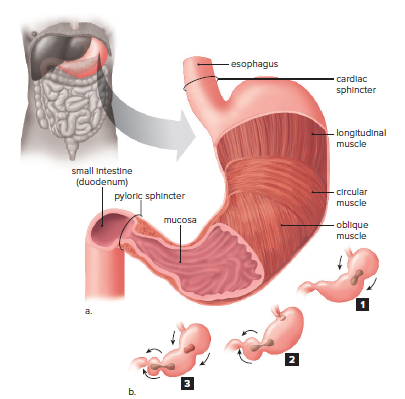
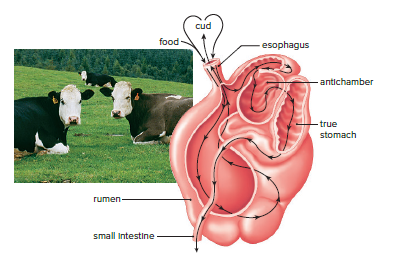
Small Intestine
Food is chewed in the mouth and mixed with salivary amylase, which digests starch to maltose.
In the stomach, pepsin digests proteins to peptides, and the contents of the digestive tract become chyme.
Chyme passes to the small intestine, where it is digested and absorbed.
The duodenum, the first part of the small intestine, receives secretions from the pancreas and liver.
The liver produces bile, which breaks up fat droplets by emulsification.
The pancreas produces pancreatic juice, which contains sodium bicarbonate and digestive enzymes.
The small intestine contains villi, which produce intestinal enzymes that complete the digestion of peptides and sugars.
Nutrient molecules are absorbed into cells throughout the body from the bloodstream.
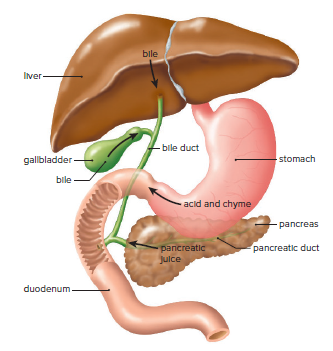
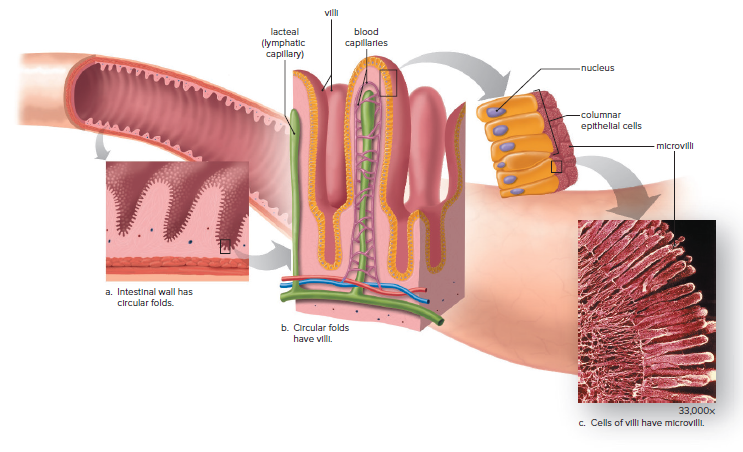
Absorption by Villi:
The small intestine wall has an extensive surface area for absorbing nutrient molecules.
Circular folds on the mucous membrane layer of the small intestine give it a corrugated appearance.
Villi are present on the surface of these circular folds.
Cells on the surface of the villi have microvilli.
Villi absorb small nutrient molecules into the body.
Each villus contains a network of blood capillaries and a lymphatic capillary called a lacteal.
Sugars and amino acids enter the blood capillaries of a villus and are carried to the liver by the hepatic portal system.
Glycerol and fatty acids enter the epithelial cells of the villi and are packaged as lipoprotein droplets, which enter a lacteal.
Absorption occurs by diffusion and active transport.
Lymphatic vessels transport lymph to cardiovascular veins.
The bloodstream carries the nutrients absorbed by the digestive system to all the cells of the body.
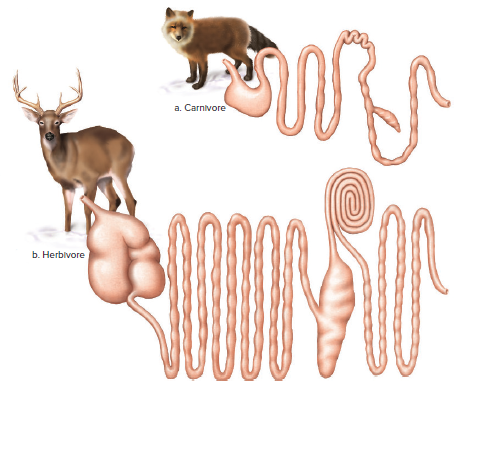
Large Intestine
The word bowel refers to the digestive tract between the stomach and the anus, but it is sometimes used to refer only to the large intestine.
The large intestine (colon) absorbs water, salts, and some vitamins, and stores indigestible material until it is eliminated at the anus.
The large intestine has a blind pouch called the cecum, with a small projection containing lymphatic tissue called the appendix.
The appendix may play a role in fighting infections by acting as a reservoir of beneficial bacteria, but if it becomes infected and bursts, it can cause peritonitis.
The large intestine has a large population of bacteria, including Escherichia coli, which break down indigestible material and produce vitamin K.
Feces are about 75% water and 25% solid matter, with almost one-third of the solid matter made up of intestinal bacteria.
A diet that includes fiber adds bulk to the feces, improves elimination regularity, and prevents constipation.
About 1.5 liters of water enter the digestive tract daily from eating and drinking, and an additional 8.5 liters enter carrying various substances secreted by digestive glands.
95% of this water is absorbed by the small intestine, and much of the remaining portion is absorbed by the large intestine.
The large intestine is more subject to the development of polyps, which can be removed surgically.
Figure 25.11 reviews the process of digestion and the roles of the digestive organs.
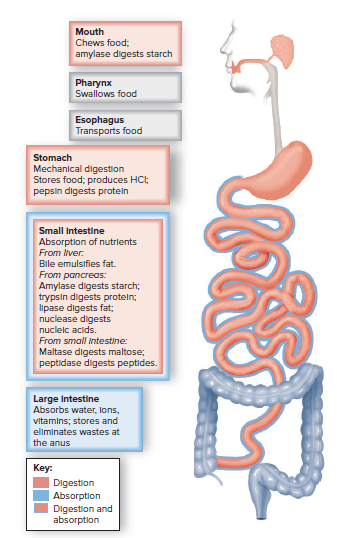
Accessory Organs
The pancreas and liver are the main accessory organs of digestion, along with the salivary glands and gallbladder. Here are some bullet points to clarify and summarize their functions:
Pancreas:
Functions as both an endocrine and exocrine gland
Produces and secretes insulin and glucagon into the bloodstream as an endocrine gland
Produces and secretes pancreatic juice into the duodenum of the small intestine through the common bile duct as an exocrine gland
Liver:
Detoxifies the blood by removing and metabolizing poisonous substances
Produces plasma proteins, destroys old red blood cells, and converts hemoglobin to the breakdown products in bile
Produces bile, which emulsifies fats in the small intestine
Stores glucose as glycogen and breaks down glycogen to glucose between meals to maintain a constant glucose concentration in the blood
Produces urea from amino acids and ammonia
Helps maintain the glucose concentration in blood at about 0.1% by removing excess glucose from the hepatic portal vein and storing it as glycogen
Converts amino acids to glucose molecules by removing amino groups from the amino acids through deamination
Can develop disorders such as jaundice, hemolytic jaundice, obstructive jaundice, hepatitis, and cirrhosis
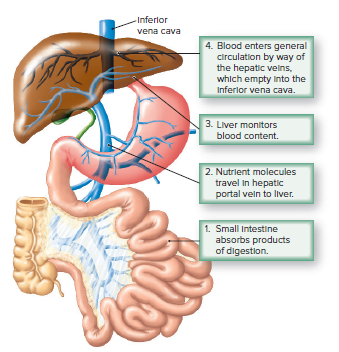
Digestive Enzymes
Smelling food and thinking about food can cause the nervous system to order the secretion of digestive juices.
Digestive juices are influenced by several peptide hormones.
Eating a protein-rich meal causes the stomach wall to produce a peptide hormone that enters the bloodstream and causes the stomach to produce more gastric juices.
The presence of protein and fat in the small intestine stimulates the secretion of bile and pancreatic juices through another peptide hormone made in the intestinal wall.
Digestive enzymes present in the digestive juices help break down carbohydrates, proteins, nucleic acids, and fats.
Starch digestion begins in the mouth with saliva from the salivary glands containing salivary amylase, the first enzyme to act on starch.

Maltose is a disaccharide that cannot be absorbed by the intestine.
Additional digestive action in the small intestine converts maltose to glucose.
Glucose can be absorbed by the intestine.
Protein digestion begins in the stomach.
Gastric juice secreted by gastric glands has a very low pH of about 2.
Gastric juice contains hydrochloric acid (HCl).
Pepsin is present in gastric juice.
Pepsin acts on a protein molecule to produce peptides.

Peptides are usually too large to be absorbed by the intestinal lining.
Peptides are broken down to amino acids in the small intestine.
Starch, proteins, fats, and nucleic acids are enzymatically broken down in the small intestine.
Pancreatic juice enters the duodenum and has a basic pH due to the presence of sodium bicarbonate (NaHCO3).
Pancreatic amylase is a pancreatic enzyme that digests starch.


Maltose, a disaccharide, cannot be absorbed by the intestine.
Additional digestive action in the small intestine converts maltose to glucose, which can be absorbed.
Protein digestion begins in the stomach.
Gastric juice secreted by gastric glands has a very low pH—about 2—because it contains hydrochloric acid (HCl).
Pepsin, which is also present in gastric juice, acts on a protein molecule to produce peptides.
Maltase and peptidases are enzymes produced by the small intestine.
Maltase completes the digestion of maltose to glucose.
Peptidases complete the digestion of proteins into amino acids.
Glucose and amino acids are small molecules that are absorbed into the cells of the villi and enter the blood.

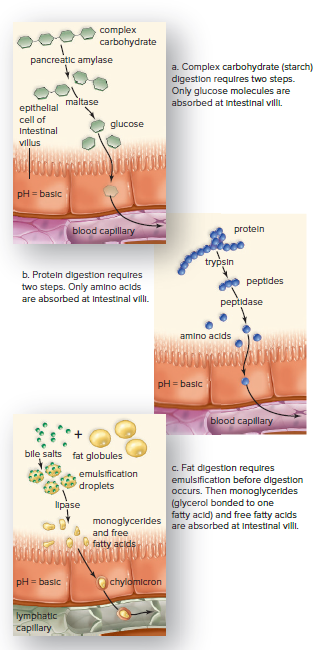
Other disaccharides have specific enzymes for digestion in the small intestine.
The lack of any of these enzymes can lead to illness.
Peptides, formed during the initial stage of protein digestion, are broken down into amino acids by peptidases.

Lipase, a third pancreatic enzyme, digests fat molecules in fat droplets that have been emulsified by bile salts.

The end products of lipase digestion are monoglycerides and fatty acids.
Monoglycerides consist of glycerol and one fatty acid.
Monoglycerides and fatty acids enter the cells of the villi.
In the cells of the villi, monoglycerides and fatty acids are rejoined and packaged as lipoprotein droplets.
Lipoprotein droplets are called chylomicrons.
Chylomicrons enter the lacteals.
25.2 Nutrition
Proper nutrition is essential for the functioning of the body's immune system, muscles, bones, and blood circulation.
Nutrients are substances in food that perform physiological functions in the body, provide energy, promote growth and development, and regulate cellular metabolism.
Nutrients help maintain fluid balance, proper pH of blood, and are involved in homeostasis.
A nutrient deficiency can lead to signs and symptoms of a deficiency disorder.
Vitamin C is needed to synthesize and maintain collagen, and its deficiency can cause gums to bleed and skin to bruise easily.
Learning about nutrition can improve diet and increase the likelihood of a longer, more active, and productive life.
Poor diet and lack of physical activity are responsible for seven of the leading ten causes of death in the United States annually.
Learning what constitutes a poor diet versus a healthy diet can help choose foods that supply all the nutrients in proper balance.
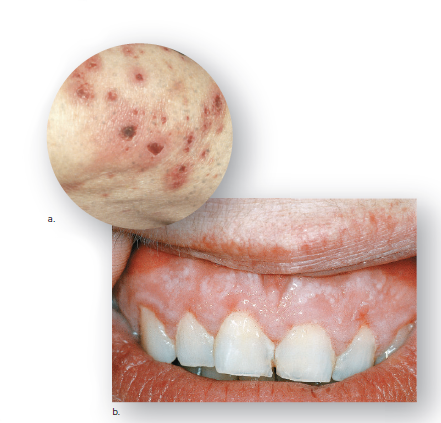
Introducing the Nutrients
A person's diet refers to their typical food choices.
Cultural and ethnic backgrounds, financial situations, environmental conditions, and psychological states influence what we eat.
A balanced diet provides all the necessary nutrients in proper proportions for a healthy body.
There are six classes of nutrients: carbohydrates, lipids, proteins, minerals, vitamins, and water.
Essential nutrients must be supplied by the diet because the body cannot produce them in sufficient quantity.
Macronutrients (carbohydrates, lipids, and proteins) are needed in large quantities, while micronutrients (vitamins and minerals) are needed in small quantities.
Macronutrients, not micronutrients, supply our energy needs.
Foods with high water content are usually lower in energy content than foods with less water and more macronutrient content.
No single naturally occurring food contains enough essential nutrients to meet all of our nutrient needs.
"Bad" or "junk" foods have nutritional value but are more appropriately called empty-calorie foods because they have high amounts of fat and/or sugar in relation to their vitamin and mineral content.
Diets that contain too many empty-calorie foods will lack enough vitamins and minerals.

25.3 The Classes of Nutrients
The human diet must contain macronutrients and micronutrients in the correct proportions.
Macronutrients are energy nutrients.
Each type of nutrient has more than one function in the body.
Nutrients can be supplied by several different food sources (refer to Table 25.1.)

Carbohydrates
Carbohydrates are present in food as sugars, starch, and fiber.
Fruits, vegetables, milk, and honey are natural sources of sugars.
Glucose and fructose are monosaccharide sugars, while lactose (milk sugar) and sucrose (table sugar) are disaccharides.
All sugars are converted to glucose for transport in the blood after absorption into the body.
Glucose is the preferred direct energy source in cells.
Plants store glucose as starch, and animals store glucose as glycogen.
High-starch foods are beans, peas, cereal grains, and potatoes.
Starch is digested to glucose in the digestive tract, and any excess glucose is stored as glycogen.
Animal sources of food, except for honey and milk, do not contain carbohydrates.
Fiber
Fiber is a type of nondigestible carbohydrate derived from plants.
Foods rich in fiber include beans, peas, nuts, fruits, and vegetables.
Whole-grain products are a good source of fiber and are more nutritious than food products made from refined grains.
During the refinement of grains, fiber, vitamins, and minerals are removed, leaving primarily starch.
Fiber cannot be digested to small molecules that enter the bloodstream, so it is not a nutrient for humans.
Insoluble fiber adds bulk to fecal material, preventing constipation.
Soluble fiber combines with bile acids and cholesterol in the small intestine and prevents them from being absorbed, protecting against heart disease.
The recommended daily intake of fiber is 25 g for women and 38 g for men.
To increase fiber intake, eat whole-grain foods, fresh fruits, and raw vegetables, and include nuts and beans in your diet.
Can Carbohydrates Be Harmful?
Following Atkins or Paleo diet may lead to the belief that carbs are unhealthy and should be avoided.
Nutritionists suggest that carbohydrates should supply a large portion of energy needs.
Americans are not eating the right kind of carbohydrates.
Traditional diets in some countries consist of 60-70% high-fiber carbohydrates and have a low incidence of diseases.
Obesity is associated with type 2 diabetes and cardiovascular disease.
High intake of refined carbohydrates and fructose sweeteners may be responsible for obesity in the US
Table 25.2 provides ways to reduce dietary sugars in the diet.
Consuming too much energy from any source contributes to body fat and increases the risk of obesity and associated illnesses.
It is difficult to determine which dietary component is responsible for the current epidemic of obesity among Americans.
There is no scientific basis for the belief that children become hyperactive after eating sugar.
Sucrose is broken down into glucose and fructose in the small intestine and absorbed into the bloodstream.
Excess glucose and fructose enters the liver, and fructose is converted to glucose.
The liver stores glucose as glycogen and breaks it down to maintain proper glucose levels.
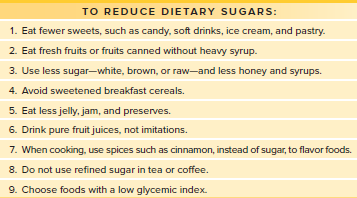
Lipids
Triglycerides supply energy for cells like carbohydrates, but fat is stored for the long term in the body.
Subcutaneous fat deposits under the skin insulate the body from cold temperatures.
Deeper fat deposits in the trunk protect organs against injury.
Nutritionists recommend unsaturated fats over saturated fats in the diet.
Alpha-linolenic and linoleic acids are essential dietary fatty acids that can be found in fatty fish and plant oils.
Delayed growth and skin problems can develop when the diet lacks essential fatty acids.
Animal foods contain saturated fats, while plant oils contain unsaturated fats.
Cholesterol is synthesized by the body and is used to make various compounds, including bile, steroid hormones, and vitamin D.
Cholesterol is an important component of the plasma membrane.
Only animal foods are rich in cholesterol, while plant foods do not contain cholesterol.
Can Lipids Be Harmful?
Elevated blood cholesterol levels increase the risk of cardiovascular disease, which is the leading cause of death in the US.
A diet high in cholesterol and saturated fats also increases the risk of cardiovascular disease.
Trans fats are even more harmful than saturated fats, and are formed when unsaturated oils are hydrogenated to produce solid fats.
Trans fatty acids can reduce the function of plasma membrane receptors that clear cholesterol from the bloodstream.
Trans fats are commonly found in processed foods, commercially fried foods, packaged snacks, vegetable shortening, and some margarine.
Table 25.3 provides information on how to reduce harmful lipids in the diet.
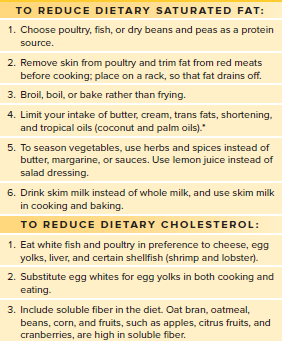
Proteins
Dietary proteins are broken down into amino acids.
Cells use amino acids to synthesize hundreds of cellular proteins.
9 out of the 20 different amino acids are essential and must be present in the diet.
Lack of essential amino acids in children's diets can result in stunted growth.
Animal-derived foods such as eggs, milk products, meat, and poultry contain all 9 essential amino acids and are considered "complete" or "high-quality" protein sources.
Plant-derived foods generally have less protein per serving and lack one or more essential amino acids, making them "incomplete" or "low-quality" protein sources.
Vegetarians can meet their protein needs by consuming grains, beans, nuts, tofu, soymilk, and other foods made from processed soybeans in various combinations.
A balanced vegetarian diet is possible with proper planning.
Can Proteins Be Harmful?
Proteins should not supply the bulk of dietary calories, according to nutritionists.
The average American eats twice as much protein as needed.
Some diets encourage protein intake instead of carbohydrates as an energy source.
Athletes may include amino acid or protein supplements in their diet to increase muscle mass.
Excess amino acids are not always converted into muscle tissue and can be used as an energy source.
The liver removes the nitrogen portion of amino acids and uses it to form urea, which is excreted in urine.
High protein diets can cause dehydration due to the water needed for the excretion of urea.
High protein diets can increase calcium loss in urine and encourage the formation of kidney stones.
Many high-protein foods contain a high amount of fat.
Minerals
The body needs 20 minerals for various physiological functions.
Major minerals are needed in higher levels than trace minerals.
More than 100mg/day of each major mineral is required in the diet.
Less than 100mg/day of each trace mineral is required in the diet.
Table 25.4 lists major and trace minerals, their functions, food sources, and health effects of too little or too much intake.
Some individuals, especially women, may not get enough iron, calcium, magnesium, or zinc in their diets.
Anemia results from a lack of iron in the diet.
Calcium supplements are taken to counteract osteoporosis.
Sodium intake should be limited to 2,300mg/day (1,500mg/day for those with high blood pressure.)
The average American takes in over 4,000mg of sodium per day.
The American Heart Association recommends limiting sodium intake to less than 1,500mg/day.
Table 25.5 provides recommendations for reducing sodium in the diet.

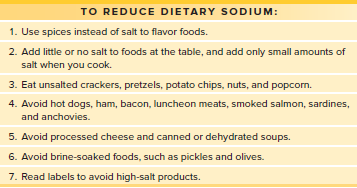
Vitamins
Vitamins are organic compounds that regulate metabolic activities.
Vitamins are classified as water-soluble or fat-soluble.
Water-soluble vitamins are readily removed in urine and must be replenished daily.
Fat-soluble vitamins are stored in adipose tissue and persist longer in the body.
Vitamins C, E, and A are antioxidants and defend the body against free radicals.
It is suggested to eat about 4½ cups of fruits and vegetables per day to obtain these vitamins.
Vitamin deficiencies can lead to disorders and even death.
Some individuals are at risk for vitamin deficiencies due to poor food choices.
Vitamin D deficiency leads to rickets, which causes bowing of the legs.
Vitamin C deficiency can lead to scurvy.
Alcohol consumption can interfere with vitamin absorption and increase excretion.
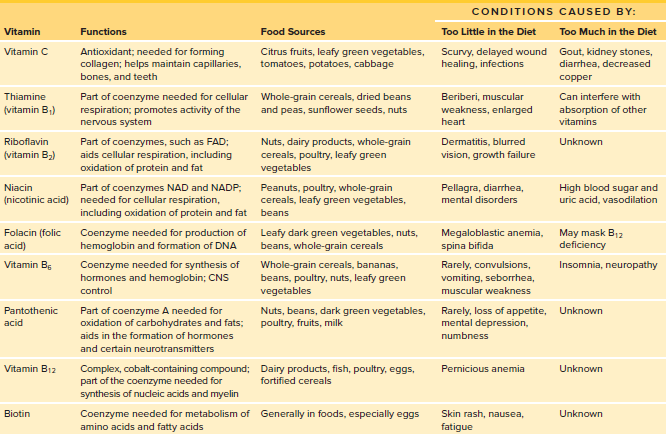

Water
Water constitutes about 60% of an adult's body.
Water participates in many chemical reactions.
Watery fluids lubricate joints, transport other nutrients, and help maintain body temperature.
Beverages, soups, fruits, and vegetables are sources of water.
Most solid foods contain some water.
The amount of total water (water from beverages and foods) that you need to consume depends on your physical activity level, your diet, and your environmental conditions.
On average, men should consume about 125 ounces (oz), and women should consume about 90 oz of total water each day.
Thirst is a healthy person's best guide for meeting water needs and avoiding dehydration.
Too much water can also be a problem.
In water toxication (hyponatremia), individuals who consume excessive amounts of water upset the balance of electrolytes, usually sodium and potassium, in their blood.
This can lead to irregular heartbeat and, in some cases, death.
25.4 Understanding Nutrition Guidelines
Planning nutritious meals and snacks involves making daily food choices based on a wide variety of information about recommended amounts of nutrients.
A day’s food intake should provide the proper balance of nutrients—neither too much nor too little of each nutrient.
Food guides can be helpful in planning your diet.
Reading the “Nutrition Facts” panel on packaged foods can help you choose healthier sources of nutrients.
Updating Dietary Guidelines
Dietary guidelines are revised every 5 years by the U.S. government.
The latest guidelines were released in 2015 by the Departments of Agriculture and Health and Human Services.
Overall purposes of guidelines are to promote health, prevent chronic long-term disease, and assist people in reaching and maintaining a healthy weight.
New guidelines focus on establishing healthy eating patterns rather than prescribing quantitative levels for nutrients.
Healthy eating pattern includes vegetables, fruits, grains, fat-free or low-fat dairy products, proteins, and oils.
Specific recommendations were made to limit certain nutrients that raise health concerns, outlined in Table 25.8.
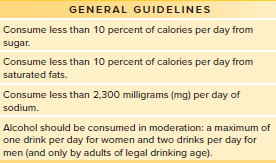
Visualizing Dietary Guidelines
The USDA has developed a guideline called MyPlate.
MyPlate is a graphical representation that replaced the older pyramids.
MyPlate helps in deciding how daily calorie intake should be distributed among food choices.
MyPlate emphasizes the proportions of each food group that should be consumed daily.
The USDA provides recommendations on the ChooseMyPlate.gov website for the minimum quantity of foods in each group that should be eaten daily.
The website also contains an interactive component, Super-Tracker, that allows tracking of personal diet and setting weight and activity goals.
The USDA provides examples of daily food plans and information on how to follow a healthy diet on a budget to support these decisions.
Making Sense of Nutrition Labels
A "Nutrition Facts" panel provides dietary information about the product and general information about the nutrients it contains.
The serving size is based on the typical serving size for the product.
The total number of Calories is based on the serving size.
The % daily value is calculated by comparing the specific information about this product with the information given at the bottom of the panel.
The % daily values are not applicable for people who require more or less than 2,000 Calories per day.
A % daily value for protein is generally not given because determining such a value would require expensive testing of the protein quality of the product by the manufacturer.
There is a % daily value for carbohydrates but not sugars, because there is no recommended daily value for sugar.
"Nutrition Facts" panels can be used to compare two products of the same type if the serving sizes are the same.

Dietary Supplements
Dietary supplements are nutrients and plant products used to enhance health.
The U.S. government does not require dietary supplements to undergo safety and effectiveness testing like prescription drugs.
Many herbal products have not been scientifically tested for benefits and can be poisonous.
Dietary supplements containing nutrients can also cause harm, especially fat-soluble vitamins A and D.
Excesses of water-soluble vitamins B6, thiamine, and C have been reported to cause toxicity.
Minerals can be harmful or deadly when ingested in excess.
Healthy people can take daily supplements with recommended amounts of vitamins and minerals.
Some individuals with metabolic diseases or physical conditions may need to add certain nutrient supplements to their diet.
High doses of dietary supplements should not be taken without consulting a physician.
The Bottom Line
A healthy diet:
Has moderate total fat intake.
Is low in saturated fats, trans fats, and cholesterol.
Is rich in whole-grain products, vegetables, and legumes as sources of complex carbohydrates and fiber.
Is low in refined carbohydrates, such as starches and sugars.
Is low in salt and sodium content.
Contains adequate amounts of protein, largely from poultry, fish, and plants.
Includes only moderate amounts of alcohol.
Contains adequate amounts of minerals and vitamins.
Avoids questionable food additives and supplements.
25.5 Nutrition and Health
Many serious disorders in Americans are linked to a diet that results in excess body fat.
In the United States, the number of people who are overweight or obese has reached epidemic proportions.
Nearly two-thirds of adult Americans have too much body fat.
Excess body fat increases the risk of type 2 diabetes, cardiovascular disease, and certain cancers.
These conditions are among the leading causes of disability and death in the United States.
Therefore, it is important for us all to stay within the recommended weight for our height.
Body Mass Index
Medical researchers use BMI to determine if a person is overweight or obese.
Height is determined genetically, while weight is influenced by other factors such as diet and lifestyle.
BMI reflects the relationship between a person's weight and height.
To calculate BMI, use the following formula:

Energy Intake Versus Energy Output
Genetics and physiological factors contribute to being overweight.
A person becomes fat by taking in more food energy (calories) than are expended.
Energy value of food is reported in kilocalories (kcal).
A kilocalorie is the amount of heat that raises the temperature of a liter of water by 1°C.
Food's caloric value can be estimated by knowing the grams of carbohydrate, fat, protein, and alcohol it contains.
Each gram of carbohydrate or protein supplies 4 kcal, each gram of fat supplies 9 kcal, and each gram of alcohol supplies 7 kcal.
A serving of food containing 30 g of carbohydrate, 9 g of fat, and 5 g of protein supplies 221 kcal.
The body expends energy for:
Metabolic functions.
Physical activity.
Digestion, absorption, and processing of nutrients from food.
Scientists can measure a person's energy expenditure for a specific physical activity by:
Measuring oxygen intake.
Measuring carbon dioxide output during the activity.

Here are the steps to estimate your daily energy needs:
Kcal needed daily for metabolic functions:
Multiply your weight in kilograms (weight in pounds divided by 2.2) times 1.0 if you are a man, and times 0.9 if you are a woman. Then multiply that number by 24.
Example: Meghan, a woman who weighs 130 pounds (about 59 kg), would calculate her daily caloric need for metabolic functions as follows: 0.9 kcal × 59 kg × 24 hours = approximately 1,274 kcal/day.
Kcal needed daily for physical activity:
Choose a multiplication factor from one of the follow categories:
Sedentary (little or no physical activity) = 0.20 to 0.40
Light (walk daily) = 0.55 to 0.65
Moderate (daily vigorous exercise) = 0.70 to 0.75
Heavy (physical labor/endurance training) = 0.80 to 1.20
Multiply this factor times the kcal value you obtained in step 1.
Example: Meghan performs light physical activity daily. She multiplies 0.55 × 1,274 kcal to determine her daily caloric need for physical activity, which is 701 kcal.
Kcal needed for digestion, absorption, and processing of nutrients:
Multiply the total kcal from steps 1 and 2 by 0.1, and add that value to the total kcal from steps 1 and 2 to get your total daily energy needs.
Example: Meghan adds 1,274 and 701 and then multiplies 1,975 kcal by 0.1 and adds that value (197.5) to 1,975 to obtain her total daily energy needs of 2,172 kcal.
Therefore, to maintain her weight of 130 pounds, Meghan needs to consume about 2,170 kcal a day and perform light physical activities.
Maintaining a Healthy Weight
To maintain weight at an appropriate level, daily kcal intake should not exceed daily kcal output.
Many Americans take in more calories than they need, leading to excess energy being converted to fat and causing overweight.
To lose weight, an overweight person needs to lower kcal intake and increase kcal output through physical activity.
Fad diets may lead to rapid weight loss, but are often nutritionally unbalanced and difficult to maintain long-term.
Permanent lifestyle changes, such as increasing physical activity and reducing portion sizes, are necessary for weight loss and maintenance.
Behavior modification can lead to safe weight loss at a reasonable rate of ½ to 2 pounds per week
Sensible eating is necessary for weight maintenance.

Disorders Associated with Obesity
Type 2 Diabetes:
Type 2 diabetes is caused by impaired insulin production and insulin resistance.
Insulin resistance causes the body's cells to fail to take up glucose, leading to high blood glucose levels and glucose in the urine.
Type 2 diabetes is often seen in people who are obese, and dietary factors are believed to contribute to its development.
A healthy diet, increased physical activity, and weight loss can improve insulin's ability to function properly in type 2 diabetics.
Simple sugars in foods, such as candy and ice cream, and sugars from the digestion of starch in white bread and potatoes can contribute to the occurrence of type 2 diabetes.
Chronically high insulin levels lead to insulin resistance, increased fat deposition, and a high level of fatty acids in the blood, which can lead to an increased risk for cardiovascular disease.
Cardiovascular Disease:
Cardiovascular disease is among the leading causes of death in the United States.
Cardiovascular disease is often due to the blockage of arteries by plaque, which contains saturated fats and cholesterol.
LDL is considered "bad" because it carries cholesterol from the liver to the cells, while HDL is considered "good" because it carries cholesterol from the cells to the liver.
Saturated fats, including trans fats, tend to raise LDL cholesterol levels, while unsaturated fats lower LDL cholesterol levels.
Beef, dairy foods, and coconut oil are rich sources of saturated fat, while foods containing partially hydrogenated oils are sources of trans fats.
Unsaturated fatty acids in olive and canola oils, most nuts, and coldwater fish tend to lower LDL cholesterol levels.
Coldwater fish contain polyunsaturated fatty acids, especially omega-3 unsaturated fatty acids, which can reduce the risk for cardiovascular disease.
Taking fish oil supplements to obtain omega-3 fatty acids is not recommended without a physician's approval.
Dietary saturated fats and trans fats raise LDL cholesterol levels more than dietary cholesterol.
Modifying the fat content of the diet, losing excess body fat, and exercising regularly can reduce blood lipid levels.
If lifestyle changes do not lower blood lipid levels enough to reduce the risk for cardiovascular disease, a physician may prescribe medication.
Eating Disorders
Many serious disorders in Americans are linked to a diet that results in excess body fat.
In the United States, the number of people who are overweight or obese has reached epidemic proportions.
Nearly two-thirds of adult Americans have too much body fat.
Excess body fat increases the risk of type 2 diabetes, cardiovascular disease, and certain cancers.
These conditions are among the leading causes of disability and death in the United States.
It is important for us all to stay within the recommended weight for our height.
People with eating disorders are dissatisfied with their body image.
Social, cultural, emotional, and biological factors all contribute to the development of an eating disorder.
These serious conditions can lead to malnutrition, disability, and death.
Early recognition and treatment are crucial for all eating disorders.
Treatment usually includes psychological counseling and antidepressant medications.
Anorexia nervosa is a severe psychological disorder characterized by an irrational fear of getting fat.
A self-imposed starvation diet is often accompanied by occasional binge eating, followed by purging and extreme physical activity to avoid weight gain.
Binges usually include large amounts of high-calorie foods, and purging episodes involve self-induced vomiting and laxative abuse.
About 90% of people suffering from anorexia nervosa are young women; an estimated 1 in 200 teenage girls is affected.
A person with bulimia nervosa binge eats, then purges to avoid gaining weight.
The binge-purge cyclic behavior can occur several times a day.
People with bulimia nervosa can be difficult to identify because their body weight is often normal, and they tend to conceal their bingeing and purging practices.
Women are more likely than men to develop bulimia; an estimated 4% of young women suffer from this condition.
Other abnormal eating practices include binge-eating disorder and muscle dysmorphia.
Many obese people suffer from binge-eating disorder, a condition characterized by episodes of overeating that are not followed by purging.
Stress, anxiety, anger, and depression can trigger food binges.
A person suffering from muscle dysmorphia thinks his or her body is underdeveloped.
Body-building activities and a preoccupation with diet and body form accompany this condition.
Unlike anorexia nervosa and bulimia, muscle dysmorphia affects more men than women.
Chapter 25: Digestion and Human Nutrition
25.1 Digestive System
One of the basic characteristics of life is the ability to acquire nutrients for energy to conduct activities of living.
In animals, the digestive system consists of organs involved in four processes:
Ingesting food
Breaking down food into smaller molecules that can be transported
Absorbing nutrient molecules
Eliminating indigestible materials
The digestive system maintains homeostasis by providing the body's cells with the nutrients they need to continue functioning.
The digestive system interacts with other organ systems of the body to maintain homeostasis.

Complete and Incomplete Digestive Systems
Hydras and planarians have an incomplete digestive system with a single opening serving as both entrance and exit.
Most animals, like earthworms, have a complete digestive tract with a tube-within-a-tube configuration.
The inner tube, or the digestive tract, has both an entrance (the mouth) and an exit (the anus).
The inner tube is separated from the outer tube (the body wall) by the coelom.
Specialized organs that assist with digestion are located within the coelom.
Digestion of food is an extracellular process in all animals, including earthworms and humans.
Digestive enzymes are produced by glands in the wall of the digestive tract or by accessory glands that lie nearby and are released into the tract.
Food is never found within these accessory glands, only within the digestive tract itself.

The Digestive Tract
The digestive tract of humans, and most other vertebrates, consists of the mouth, esophagus, stomach, small intestine, and large intestine.

Mouth
The digestive system in humans begins with the mouth, where food is chewed into pieces, starting the process of mechanical digestion.
Many vertebrates have teeth, but birds lack teeth and use small pebbles in their gizzard to break up food.
Mammals' teeth reflect their diet, with carnivores having easily digestible meat and herbivores needing to break down cellulose walls in plant material.
Humans are omnivores with sharp incisors for biting, pointed canines for tearing, and premolars and molars for grinding and crushing food.
Digestive enzymes break down large molecules in food to smaller molecules.
Salivary glands in the mouth produce saliva, including salivary amylase which breaks down starch to maltose.
The tongue manipulates food and mixes it with saliva to form a bolus, which is then swallowed.

Swallowing
The human digestive and respiratory passages meet in the pharynx and then separate.
When food is swallowed, the soft palate moves up to close off the nasal cavities.
The epiglottis covers the glottis to prevent food from entering the larynx.
The bolus must move through the pharynx and into the esophagus because the air passages are blocked.
Food can sometimes go the wrong way, either into the nasal cavities or into the trachea.
The esophagus is a muscular tube that takes food to the stomach.
Peristalsis, a series of rhythmic contractions of smooth muscles, moves the contents along in tubular organs, including the esophagus.

Stomach
The human stomach:
Thick-walled, J-shaped organ on the left side of the abdominal cavity below the liver.
Continuous with the esophagus above and the duodenum of the small intestine below.
The cardiac sphincter separates the esophagus from the stomach.
About 25 cm (10 in.) long, regardless of the amount of food it holds.
The diameter varies depending on how full it is.
Receives food from the esophagus, stores food, starts the digestion of proteins, and moves food into the small intestine.
Wall has deep folds which disappear as the stomach fills to an approximate capacity of 1 liter.
Contains three muscle layers: longitudinal, circular, and obliquely arranged.
Mechanically digests food by contracting vigorously to mix it with digestive juices.
The epithelial lining of the stomach called a mucosa, has millions of gastric glands.
Gastric glands produce gastric juice containing hydrochloric acid and pepsin.
Strong acidity kills microbes and promotes the activity of pepsin.
Low pH sometimes causes heartburn or gastric reflux disease.
A thick layer of mucus protects the wall of the stomach from enzymatic action.
Ulcers are open sores in the wall caused by the gradual destruction of tissues.
Alcohol and other liquids are absorbed in the stomach, but other nutrients are not.
Peristalsis pushes food along in the stomach.
The pyloric sphincter is a narrow opening at the base of the stomach.
Chyme is a thick, soupy liquid that leaves the stomach and squirts through the pyloric sphincter into the small intestine.
Ruminants:
A type of mammal that includes cattle, sheep, goats, deer, and buffalo.
Named for a part of their stomach, the rumen.
Rumen contains symbiotic bacteria and protozoans that produce enzymes that can digest cellulose.
Herbivores feed on grass, which goes to the rumen and is broken down by the microbes, becoming small balls of cud.
Cud returns to the mouth, where the animal "chews the cud."
Cud may return to the rumen for a second go-round before passing through the other chambers of the stomach.
Rumen is an adaptation to a diet rich in fiber that may have been promoted by competition among the many types of animals that feed on grass.


Small Intestine
Food is chewed in the mouth and mixed with salivary amylase, which digests starch to maltose.
In the stomach, pepsin digests proteins to peptides, and the contents of the digestive tract become chyme.
Chyme passes to the small intestine, where it is digested and absorbed.
The duodenum, the first part of the small intestine, receives secretions from the pancreas and liver.
The liver produces bile, which breaks up fat droplets by emulsification.
The pancreas produces pancreatic juice, which contains sodium bicarbonate and digestive enzymes.
The small intestine contains villi, which produce intestinal enzymes that complete the digestion of peptides and sugars.
Nutrient molecules are absorbed into cells throughout the body from the bloodstream.


Absorption by Villi:
The small intestine wall has an extensive surface area for absorbing nutrient molecules.
Circular folds on the mucous membrane layer of the small intestine give it a corrugated appearance.
Villi are present on the surface of these circular folds.
Cells on the surface of the villi have microvilli.
Villi absorb small nutrient molecules into the body.
Each villus contains a network of blood capillaries and a lymphatic capillary called a lacteal.
Sugars and amino acids enter the blood capillaries of a villus and are carried to the liver by the hepatic portal system.
Glycerol and fatty acids enter the epithelial cells of the villi and are packaged as lipoprotein droplets, which enter a lacteal.
Absorption occurs by diffusion and active transport.
Lymphatic vessels transport lymph to cardiovascular veins.
The bloodstream carries the nutrients absorbed by the digestive system to all the cells of the body.

Large Intestine
The word bowel refers to the digestive tract between the stomach and the anus, but it is sometimes used to refer only to the large intestine.
The large intestine (colon) absorbs water, salts, and some vitamins, and stores indigestible material until it is eliminated at the anus.
The large intestine has a blind pouch called the cecum, with a small projection containing lymphatic tissue called the appendix.
The appendix may play a role in fighting infections by acting as a reservoir of beneficial bacteria, but if it becomes infected and bursts, it can cause peritonitis.
The large intestine has a large population of bacteria, including Escherichia coli, which break down indigestible material and produce vitamin K.
Feces are about 75% water and 25% solid matter, with almost one-third of the solid matter made up of intestinal bacteria.
A diet that includes fiber adds bulk to the feces, improves elimination regularity, and prevents constipation.
About 1.5 liters of water enter the digestive tract daily from eating and drinking, and an additional 8.5 liters enter carrying various substances secreted by digestive glands.
95% of this water is absorbed by the small intestine, and much of the remaining portion is absorbed by the large intestine.
The large intestine is more subject to the development of polyps, which can be removed surgically.
Figure 25.11 reviews the process of digestion and the roles of the digestive organs.

Accessory Organs
The pancreas and liver are the main accessory organs of digestion, along with the salivary glands and gallbladder. Here are some bullet points to clarify and summarize their functions:
Pancreas:
Functions as both an endocrine and exocrine gland
Produces and secretes insulin and glucagon into the bloodstream as an endocrine gland
Produces and secretes pancreatic juice into the duodenum of the small intestine through the common bile duct as an exocrine gland
Liver:
Detoxifies the blood by removing and metabolizing poisonous substances
Produces plasma proteins, destroys old red blood cells, and converts hemoglobin to the breakdown products in bile
Produces bile, which emulsifies fats in the small intestine
Stores glucose as glycogen and breaks down glycogen to glucose between meals to maintain a constant glucose concentration in the blood
Produces urea from amino acids and ammonia
Helps maintain the glucose concentration in blood at about 0.1% by removing excess glucose from the hepatic portal vein and storing it as glycogen
Converts amino acids to glucose molecules by removing amino groups from the amino acids through deamination
Can develop disorders such as jaundice, hemolytic jaundice, obstructive jaundice, hepatitis, and cirrhosis

Digestive Enzymes
Smelling food and thinking about food can cause the nervous system to order the secretion of digestive juices.
Digestive juices are influenced by several peptide hormones.
Eating a protein-rich meal causes the stomach wall to produce a peptide hormone that enters the bloodstream and causes the stomach to produce more gastric juices.
The presence of protein and fat in the small intestine stimulates the secretion of bile and pancreatic juices through another peptide hormone made in the intestinal wall.
Digestive enzymes present in the digestive juices help break down carbohydrates, proteins, nucleic acids, and fats.
Starch digestion begins in the mouth with saliva from the salivary glands containing salivary amylase, the first enzyme to act on starch.

Maltose is a disaccharide that cannot be absorbed by the intestine.
Additional digestive action in the small intestine converts maltose to glucose.
Glucose can be absorbed by the intestine.
Protein digestion begins in the stomach.
Gastric juice secreted by gastric glands has a very low pH of about 2.
Gastric juice contains hydrochloric acid (HCl).
Pepsin is present in gastric juice.
Pepsin acts on a protein molecule to produce peptides.

Peptides are usually too large to be absorbed by the intestinal lining.
Peptides are broken down to amino acids in the small intestine.
Starch, proteins, fats, and nucleic acids are enzymatically broken down in the small intestine.
Pancreatic juice enters the duodenum and has a basic pH due to the presence of sodium bicarbonate (NaHCO3).
Pancreatic amylase is a pancreatic enzyme that digests starch.


Maltose, a disaccharide, cannot be absorbed by the intestine.
Additional digestive action in the small intestine converts maltose to glucose, which can be absorbed.
Protein digestion begins in the stomach.
Gastric juice secreted by gastric glands has a very low pH—about 2—because it contains hydrochloric acid (HCl).
Pepsin, which is also present in gastric juice, acts on a protein molecule to produce peptides.
Maltase and peptidases are enzymes produced by the small intestine.
Maltase completes the digestion of maltose to glucose.
Peptidases complete the digestion of proteins into amino acids.
Glucose and amino acids are small molecules that are absorbed into the cells of the villi and enter the blood.


Other disaccharides have specific enzymes for digestion in the small intestine.
The lack of any of these enzymes can lead to illness.
Peptides, formed during the initial stage of protein digestion, are broken down into amino acids by peptidases.

Lipase, a third pancreatic enzyme, digests fat molecules in fat droplets that have been emulsified by bile salts.

The end products of lipase digestion are monoglycerides and fatty acids.
Monoglycerides consist of glycerol and one fatty acid.
Monoglycerides and fatty acids enter the cells of the villi.
In the cells of the villi, monoglycerides and fatty acids are rejoined and packaged as lipoprotein droplets.
Lipoprotein droplets are called chylomicrons.
Chylomicrons enter the lacteals.
25.2 Nutrition
Proper nutrition is essential for the functioning of the body's immune system, muscles, bones, and blood circulation.
Nutrients are substances in food that perform physiological functions in the body, provide energy, promote growth and development, and regulate cellular metabolism.
Nutrients help maintain fluid balance, proper pH of blood, and are involved in homeostasis.
A nutrient deficiency can lead to signs and symptoms of a deficiency disorder.
Vitamin C is needed to synthesize and maintain collagen, and its deficiency can cause gums to bleed and skin to bruise easily.
Learning about nutrition can improve diet and increase the likelihood of a longer, more active, and productive life.
Poor diet and lack of physical activity are responsible for seven of the leading ten causes of death in the United States annually.
Learning what constitutes a poor diet versus a healthy diet can help choose foods that supply all the nutrients in proper balance.

Introducing the Nutrients
A person's diet refers to their typical food choices.
Cultural and ethnic backgrounds, financial situations, environmental conditions, and psychological states influence what we eat.
A balanced diet provides all the necessary nutrients in proper proportions for a healthy body.
There are six classes of nutrients: carbohydrates, lipids, proteins, minerals, vitamins, and water.
Essential nutrients must be supplied by the diet because the body cannot produce them in sufficient quantity.
Macronutrients (carbohydrates, lipids, and proteins) are needed in large quantities, while micronutrients (vitamins and minerals) are needed in small quantities.
Macronutrients, not micronutrients, supply our energy needs.
Foods with high water content are usually lower in energy content than foods with less water and more macronutrient content.
No single naturally occurring food contains enough essential nutrients to meet all of our nutrient needs.
"Bad" or "junk" foods have nutritional value but are more appropriately called empty-calorie foods because they have high amounts of fat and/or sugar in relation to their vitamin and mineral content.
Diets that contain too many empty-calorie foods will lack enough vitamins and minerals.

25.3 The Classes of Nutrients
The human diet must contain macronutrients and micronutrients in the correct proportions.
Macronutrients are energy nutrients.
Each type of nutrient has more than one function in the body.
Nutrients can be supplied by several different food sources (refer to Table 25.1.)

Carbohydrates
Carbohydrates are present in food as sugars, starch, and fiber.
Fruits, vegetables, milk, and honey are natural sources of sugars.
Glucose and fructose are monosaccharide sugars, while lactose (milk sugar) and sucrose (table sugar) are disaccharides.
All sugars are converted to glucose for transport in the blood after absorption into the body.
Glucose is the preferred direct energy source in cells.
Plants store glucose as starch, and animals store glucose as glycogen.
High-starch foods are beans, peas, cereal grains, and potatoes.
Starch is digested to glucose in the digestive tract, and any excess glucose is stored as glycogen.
Animal sources of food, except for honey and milk, do not contain carbohydrates.
Fiber
Fiber is a type of nondigestible carbohydrate derived from plants.
Foods rich in fiber include beans, peas, nuts, fruits, and vegetables.
Whole-grain products are a good source of fiber and are more nutritious than food products made from refined grains.
During the refinement of grains, fiber, vitamins, and minerals are removed, leaving primarily starch.
Fiber cannot be digested to small molecules that enter the bloodstream, so it is not a nutrient for humans.
Insoluble fiber adds bulk to fecal material, preventing constipation.
Soluble fiber combines with bile acids and cholesterol in the small intestine and prevents them from being absorbed, protecting against heart disease.
The recommended daily intake of fiber is 25 g for women and 38 g for men.
To increase fiber intake, eat whole-grain foods, fresh fruits, and raw vegetables, and include nuts and beans in your diet.
Can Carbohydrates Be Harmful?
Following Atkins or Paleo diet may lead to the belief that carbs are unhealthy and should be avoided.
Nutritionists suggest that carbohydrates should supply a large portion of energy needs.
Americans are not eating the right kind of carbohydrates.
Traditional diets in some countries consist of 60-70% high-fiber carbohydrates and have a low incidence of diseases.
Obesity is associated with type 2 diabetes and cardiovascular disease.
High intake of refined carbohydrates and fructose sweeteners may be responsible for obesity in the US
Table 25.2 provides ways to reduce dietary sugars in the diet.
Consuming too much energy from any source contributes to body fat and increases the risk of obesity and associated illnesses.
It is difficult to determine which dietary component is responsible for the current epidemic of obesity among Americans.
There is no scientific basis for the belief that children become hyperactive after eating sugar.
Sucrose is broken down into glucose and fructose in the small intestine and absorbed into the bloodstream.
Excess glucose and fructose enters the liver, and fructose is converted to glucose.
The liver stores glucose as glycogen and breaks it down to maintain proper glucose levels.

Lipids
Triglycerides supply energy for cells like carbohydrates, but fat is stored for the long term in the body.
Subcutaneous fat deposits under the skin insulate the body from cold temperatures.
Deeper fat deposits in the trunk protect organs against injury.
Nutritionists recommend unsaturated fats over saturated fats in the diet.
Alpha-linolenic and linoleic acids are essential dietary fatty acids that can be found in fatty fish and plant oils.
Delayed growth and skin problems can develop when the diet lacks essential fatty acids.
Animal foods contain saturated fats, while plant oils contain unsaturated fats.
Cholesterol is synthesized by the body and is used to make various compounds, including bile, steroid hormones, and vitamin D.
Cholesterol is an important component of the plasma membrane.
Only animal foods are rich in cholesterol, while plant foods do not contain cholesterol.
Can Lipids Be Harmful?
Elevated blood cholesterol levels increase the risk of cardiovascular disease, which is the leading cause of death in the US.
A diet high in cholesterol and saturated fats also increases the risk of cardiovascular disease.
Trans fats are even more harmful than saturated fats, and are formed when unsaturated oils are hydrogenated to produce solid fats.
Trans fatty acids can reduce the function of plasma membrane receptors that clear cholesterol from the bloodstream.
Trans fats are commonly found in processed foods, commercially fried foods, packaged snacks, vegetable shortening, and some margarine.
Table 25.3 provides information on how to reduce harmful lipids in the diet.

Proteins
Dietary proteins are broken down into amino acids.
Cells use amino acids to synthesize hundreds of cellular proteins.
9 out of the 20 different amino acids are essential and must be present in the diet.
Lack of essential amino acids in children's diets can result in stunted growth.
Animal-derived foods such as eggs, milk products, meat, and poultry contain all 9 essential amino acids and are considered "complete" or "high-quality" protein sources.
Plant-derived foods generally have less protein per serving and lack one or more essential amino acids, making them "incomplete" or "low-quality" protein sources.
Vegetarians can meet their protein needs by consuming grains, beans, nuts, tofu, soymilk, and other foods made from processed soybeans in various combinations.
A balanced vegetarian diet is possible with proper planning.
Can Proteins Be Harmful?
Proteins should not supply the bulk of dietary calories, according to nutritionists.
The average American eats twice as much protein as needed.
Some diets encourage protein intake instead of carbohydrates as an energy source.
Athletes may include amino acid or protein supplements in their diet to increase muscle mass.
Excess amino acids are not always converted into muscle tissue and can be used as an energy source.
The liver removes the nitrogen portion of amino acids and uses it to form urea, which is excreted in urine.
High protein diets can cause dehydration due to the water needed for the excretion of urea.
High protein diets can increase calcium loss in urine and encourage the formation of kidney stones.
Many high-protein foods contain a high amount of fat.
Minerals
The body needs 20 minerals for various physiological functions.
Major minerals are needed in higher levels than trace minerals.
More than 100mg/day of each major mineral is required in the diet.
Less than 100mg/day of each trace mineral is required in the diet.
Table 25.4 lists major and trace minerals, their functions, food sources, and health effects of too little or too much intake.
Some individuals, especially women, may not get enough iron, calcium, magnesium, or zinc in their diets.
Anemia results from a lack of iron in the diet.
Calcium supplements are taken to counteract osteoporosis.
Sodium intake should be limited to 2,300mg/day (1,500mg/day for those with high blood pressure.)
The average American takes in over 4,000mg of sodium per day.
The American Heart Association recommends limiting sodium intake to less than 1,500mg/day.
Table 25.5 provides recommendations for reducing sodium in the diet.


Vitamins
Vitamins are organic compounds that regulate metabolic activities.
Vitamins are classified as water-soluble or fat-soluble.
Water-soluble vitamins are readily removed in urine and must be replenished daily.
Fat-soluble vitamins are stored in adipose tissue and persist longer in the body.
Vitamins C, E, and A are antioxidants and defend the body against free radicals.
It is suggested to eat about 4½ cups of fruits and vegetables per day to obtain these vitamins.
Vitamin deficiencies can lead to disorders and even death.
Some individuals are at risk for vitamin deficiencies due to poor food choices.
Vitamin D deficiency leads to rickets, which causes bowing of the legs.
Vitamin C deficiency can lead to scurvy.
Alcohol consumption can interfere with vitamin absorption and increase excretion.


Water
Water constitutes about 60% of an adult's body.
Water participates in many chemical reactions.
Watery fluids lubricate joints, transport other nutrients, and help maintain body temperature.
Beverages, soups, fruits, and vegetables are sources of water.
Most solid foods contain some water.
The amount of total water (water from beverages and foods) that you need to consume depends on your physical activity level, your diet, and your environmental conditions.
On average, men should consume about 125 ounces (oz), and women should consume about 90 oz of total water each day.
Thirst is a healthy person's best guide for meeting water needs and avoiding dehydration.
Too much water can also be a problem.
In water toxication (hyponatremia), individuals who consume excessive amounts of water upset the balance of electrolytes, usually sodium and potassium, in their blood.
This can lead to irregular heartbeat and, in some cases, death.
25.4 Understanding Nutrition Guidelines
Planning nutritious meals and snacks involves making daily food choices based on a wide variety of information about recommended amounts of nutrients.
A day’s food intake should provide the proper balance of nutrients—neither too much nor too little of each nutrient.
Food guides can be helpful in planning your diet.
Reading the “Nutrition Facts” panel on packaged foods can help you choose healthier sources of nutrients.
Updating Dietary Guidelines
Dietary guidelines are revised every 5 years by the U.S. government.
The latest guidelines were released in 2015 by the Departments of Agriculture and Health and Human Services.
Overall purposes of guidelines are to promote health, prevent chronic long-term disease, and assist people in reaching and maintaining a healthy weight.
New guidelines focus on establishing healthy eating patterns rather than prescribing quantitative levels for nutrients.
Healthy eating pattern includes vegetables, fruits, grains, fat-free or low-fat dairy products, proteins, and oils.
Specific recommendations were made to limit certain nutrients that raise health concerns, outlined in Table 25.8.

Visualizing Dietary Guidelines
The USDA has developed a guideline called MyPlate.
MyPlate is a graphical representation that replaced the older pyramids.
MyPlate helps in deciding how daily calorie intake should be distributed among food choices.
MyPlate emphasizes the proportions of each food group that should be consumed daily.
The USDA provides recommendations on the ChooseMyPlate.gov website for the minimum quantity of foods in each group that should be eaten daily.
The website also contains an interactive component, Super-Tracker, that allows tracking of personal diet and setting weight and activity goals.
The USDA provides examples of daily food plans and information on how to follow a healthy diet on a budget to support these decisions.
Making Sense of Nutrition Labels
A "Nutrition Facts" panel provides dietary information about the product and general information about the nutrients it contains.
The serving size is based on the typical serving size for the product.
The total number of Calories is based on the serving size.
The % daily value is calculated by comparing the specific information about this product with the information given at the bottom of the panel.
The % daily values are not applicable for people who require more or less than 2,000 Calories per day.
A % daily value for protein is generally not given because determining such a value would require expensive testing of the protein quality of the product by the manufacturer.
There is a % daily value for carbohydrates but not sugars, because there is no recommended daily value for sugar.
"Nutrition Facts" panels can be used to compare two products of the same type if the serving sizes are the same.

Dietary Supplements
Dietary supplements are nutrients and plant products used to enhance health.
The U.S. government does not require dietary supplements to undergo safety and effectiveness testing like prescription drugs.
Many herbal products have not been scientifically tested for benefits and can be poisonous.
Dietary supplements containing nutrients can also cause harm, especially fat-soluble vitamins A and D.
Excesses of water-soluble vitamins B6, thiamine, and C have been reported to cause toxicity.
Minerals can be harmful or deadly when ingested in excess.
Healthy people can take daily supplements with recommended amounts of vitamins and minerals.
Some individuals with metabolic diseases or physical conditions may need to add certain nutrient supplements to their diet.
High doses of dietary supplements should not be taken without consulting a physician.
The Bottom Line
A healthy diet:
Has moderate total fat intake.
Is low in saturated fats, trans fats, and cholesterol.
Is rich in whole-grain products, vegetables, and legumes as sources of complex carbohydrates and fiber.
Is low in refined carbohydrates, such as starches and sugars.
Is low in salt and sodium content.
Contains adequate amounts of protein, largely from poultry, fish, and plants.
Includes only moderate amounts of alcohol.
Contains adequate amounts of minerals and vitamins.
Avoids questionable food additives and supplements.
25.5 Nutrition and Health
Many serious disorders in Americans are linked to a diet that results in excess body fat.
In the United States, the number of people who are overweight or obese has reached epidemic proportions.
Nearly two-thirds of adult Americans have too much body fat.
Excess body fat increases the risk of type 2 diabetes, cardiovascular disease, and certain cancers.
These conditions are among the leading causes of disability and death in the United States.
Therefore, it is important for us all to stay within the recommended weight for our height.
Body Mass Index
Medical researchers use BMI to determine if a person is overweight or obese.
Height is determined genetically, while weight is influenced by other factors such as diet and lifestyle.
BMI reflects the relationship between a person's weight and height.
To calculate BMI, use the following formula:

Energy Intake Versus Energy Output
Genetics and physiological factors contribute to being overweight.
A person becomes fat by taking in more food energy (calories) than are expended.
Energy value of food is reported in kilocalories (kcal).
A kilocalorie is the amount of heat that raises the temperature of a liter of water by 1°C.
Food's caloric value can be estimated by knowing the grams of carbohydrate, fat, protein, and alcohol it contains.
Each gram of carbohydrate or protein supplies 4 kcal, each gram of fat supplies 9 kcal, and each gram of alcohol supplies 7 kcal.
A serving of food containing 30 g of carbohydrate, 9 g of fat, and 5 g of protein supplies 221 kcal.
The body expends energy for:
Metabolic functions.
Physical activity.
Digestion, absorption, and processing of nutrients from food.
Scientists can measure a person's energy expenditure for a specific physical activity by:
Measuring oxygen intake.
Measuring carbon dioxide output during the activity.

Here are the steps to estimate your daily energy needs:
Kcal needed daily for metabolic functions:
Multiply your weight in kilograms (weight in pounds divided by 2.2) times 1.0 if you are a man, and times 0.9 if you are a woman. Then multiply that number by 24.
Example: Meghan, a woman who weighs 130 pounds (about 59 kg), would calculate her daily caloric need for metabolic functions as follows: 0.9 kcal × 59 kg × 24 hours = approximately 1,274 kcal/day.
Kcal needed daily for physical activity:
Choose a multiplication factor from one of the follow categories:
Sedentary (little or no physical activity) = 0.20 to 0.40
Light (walk daily) = 0.55 to 0.65
Moderate (daily vigorous exercise) = 0.70 to 0.75
Heavy (physical labor/endurance training) = 0.80 to 1.20
Multiply this factor times the kcal value you obtained in step 1.
Example: Meghan performs light physical activity daily. She multiplies 0.55 × 1,274 kcal to determine her daily caloric need for physical activity, which is 701 kcal.
Kcal needed for digestion, absorption, and processing of nutrients:
Multiply the total kcal from steps 1 and 2 by 0.1, and add that value to the total kcal from steps 1 and 2 to get your total daily energy needs.
Example: Meghan adds 1,274 and 701 and then multiplies 1,975 kcal by 0.1 and adds that value (197.5) to 1,975 to obtain her total daily energy needs of 2,172 kcal.
Therefore, to maintain her weight of 130 pounds, Meghan needs to consume about 2,170 kcal a day and perform light physical activities.
Maintaining a Healthy Weight
To maintain weight at an appropriate level, daily kcal intake should not exceed daily kcal output.
Many Americans take in more calories than they need, leading to excess energy being converted to fat and causing overweight.
To lose weight, an overweight person needs to lower kcal intake and increase kcal output through physical activity.
Fad diets may lead to rapid weight loss, but are often nutritionally unbalanced and difficult to maintain long-term.
Permanent lifestyle changes, such as increasing physical activity and reducing portion sizes, are necessary for weight loss and maintenance.
Behavior modification can lead to safe weight loss at a reasonable rate of ½ to 2 pounds per week
Sensible eating is necessary for weight maintenance.

Disorders Associated with Obesity
Type 2 Diabetes:
Type 2 diabetes is caused by impaired insulin production and insulin resistance.
Insulin resistance causes the body's cells to fail to take up glucose, leading to high blood glucose levels and glucose in the urine.
Type 2 diabetes is often seen in people who are obese, and dietary factors are believed to contribute to its development.
A healthy diet, increased physical activity, and weight loss can improve insulin's ability to function properly in type 2 diabetics.
Simple sugars in foods, such as candy and ice cream, and sugars from the digestion of starch in white bread and potatoes can contribute to the occurrence of type 2 diabetes.
Chronically high insulin levels lead to insulin resistance, increased fat deposition, and a high level of fatty acids in the blood, which can lead to an increased risk for cardiovascular disease.
Cardiovascular Disease:
Cardiovascular disease is among the leading causes of death in the United States.
Cardiovascular disease is often due to the blockage of arteries by plaque, which contains saturated fats and cholesterol.
LDL is considered "bad" because it carries cholesterol from the liver to the cells, while HDL is considered "good" because it carries cholesterol from the cells to the liver.
Saturated fats, including trans fats, tend to raise LDL cholesterol levels, while unsaturated fats lower LDL cholesterol levels.
Beef, dairy foods, and coconut oil are rich sources of saturated fat, while foods containing partially hydrogenated oils are sources of trans fats.
Unsaturated fatty acids in olive and canola oils, most nuts, and coldwater fish tend to lower LDL cholesterol levels.
Coldwater fish contain polyunsaturated fatty acids, especially omega-3 unsaturated fatty acids, which can reduce the risk for cardiovascular disease.
Taking fish oil supplements to obtain omega-3 fatty acids is not recommended without a physician's approval.
Dietary saturated fats and trans fats raise LDL cholesterol levels more than dietary cholesterol.
Modifying the fat content of the diet, losing excess body fat, and exercising regularly can reduce blood lipid levels.
If lifestyle changes do not lower blood lipid levels enough to reduce the risk for cardiovascular disease, a physician may prescribe medication.
Eating Disorders
Many serious disorders in Americans are linked to a diet that results in excess body fat.
In the United States, the number of people who are overweight or obese has reached epidemic proportions.
Nearly two-thirds of adult Americans have too much body fat.
Excess body fat increases the risk of type 2 diabetes, cardiovascular disease, and certain cancers.
These conditions are among the leading causes of disability and death in the United States.
It is important for us all to stay within the recommended weight for our height.
People with eating disorders are dissatisfied with their body image.
Social, cultural, emotional, and biological factors all contribute to the development of an eating disorder.
These serious conditions can lead to malnutrition, disability, and death.
Early recognition and treatment are crucial for all eating disorders.
Treatment usually includes psychological counseling and antidepressant medications.
Anorexia nervosa is a severe psychological disorder characterized by an irrational fear of getting fat.
A self-imposed starvation diet is often accompanied by occasional binge eating, followed by purging and extreme physical activity to avoid weight gain.
Binges usually include large amounts of high-calorie foods, and purging episodes involve self-induced vomiting and laxative abuse.
About 90% of people suffering from anorexia nervosa are young women; an estimated 1 in 200 teenage girls is affected.
A person with bulimia nervosa binge eats, then purges to avoid gaining weight.
The binge-purge cyclic behavior can occur several times a day.
People with bulimia nervosa can be difficult to identify because their body weight is often normal, and they tend to conceal their bingeing and purging practices.
Women are more likely than men to develop bulimia; an estimated 4% of young women suffer from this condition.
Other abnormal eating practices include binge-eating disorder and muscle dysmorphia.
Many obese people suffer from binge-eating disorder, a condition characterized by episodes of overeating that are not followed by purging.
Stress, anxiety, anger, and depression can trigger food binges.
A person suffering from muscle dysmorphia thinks his or her body is underdeveloped.
Body-building activities and a preoccupation with diet and body form accompany this condition.
Unlike anorexia nervosa and bulimia, muscle dysmorphia affects more men than women.
 Knowt
Knowt
